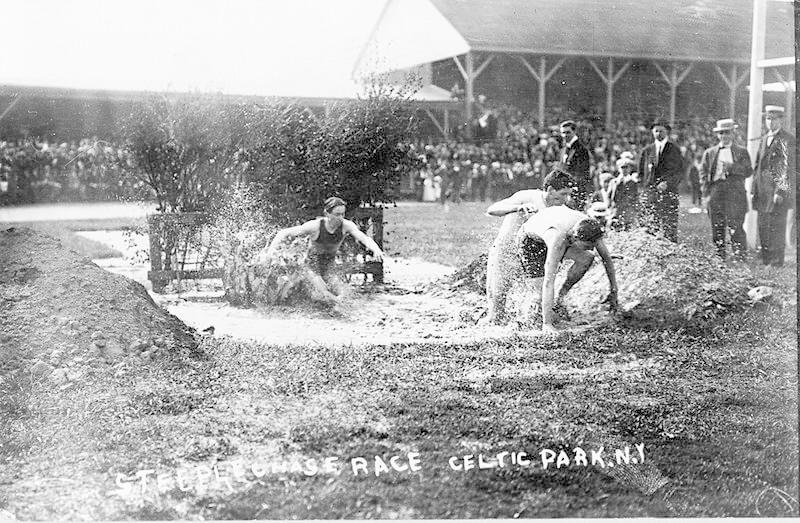What It Takes To Be A Steeplechase

Thirty-five barriers, seven of which are water jumps, over 3000 meters around the track. Ragged breathing, moments of silent suspension as athletes leap and ponytails and elbows swing wildly, the frump of dozens of spiked feet touching down on the other side of the barrier. The sonorous hissing of disturbed water as, once a lap, these same athletes launch themselves over the water barrier, ideally avoiding it altogether, usually one-footing it, sometimes miscalculating and sprawling into the pit in spectacularly undignified fashion.
Welcome to the steeplechase, track and field’s least-known and arguably most appalling running event. Legend has it this absurd event has its origins in England, where one day, long ago, gentlemen had agreed to settle a dispute via a display of athletic prowess—that is, a horse race. However, when the day of the race dawned with conditions too dangerous to race over the hills on horseback, one determined fellow declared that the race would happen, and the dispute would be settled. On foot. Thus, the myth of steeplechase was born. Picture it: Grown English men in rolled-up riding pants and riding jackets flapping wildly as they careened over the hills and through puddles of water in a dash to prove a point. And so the spirit of the event was born.

The absurdity of the steeplechase endures today, just as the unclassifiable mindset of the steeplechase-runner does. Regardless of ability level, those of us called to steeplechase (yes, it is something you’re called to, and yes, it is a bit of a cult) harbor something inside that is distinctly steeplechase. Toeing the line, these athletes face an impossible, unquantifiable number of scenarios, ranging from the predictable (falling in the water pit) to the unbelievable (losing a shoe in the water pit—and then putting it back on). At their core, steeplechasers are, first and foremost, resilient. Tough. Lock-jawed in the face of adversity. But it’s hard to say what, specifically, draws each athlete to the event. For many, the honest-to-goodness truth is that the event was an accidental discovery.
Today’s giants in the American steeplechase world include names like Evan Jager (North American record-holder in the event and silver-medalist in Rio), Emma Coburn (the first American woman to ever podium in the event at the Olympics; she earned bronze in Rio), and rising women’s stars Colleen Quigley (8th in Rio) and Courtney Frerichs (11th in Rio), both of whom rounded out the American line-up for the event in Rio. Although the women’s steeplechase was only added to the Olympics in 2008 (the men’s event, standardized at 3000m, has been around since 1920), recent American scrappiness in the face of Kenyan and Ethiopian giants is slowly earning the event more attention—especially on the women’s side.

Read also about best running shoes for cross country.
Express interest early
Approach your coach after cross country season and let them know that you have a mind to try steeplechase, and work with them to incorporate elements of steeplechase training into your regimen as you build your base back up. Initially, training won’t look all that different from those who aren’t interested in steeplechase—the slow, longer mileage easing back into shorter tempos, and then longer tempos—are necessary for the steeplechaser too.

By Robbie Dale (Flickr: The Water Jump) [CC BY-SA 2.0 (http://creativecommons.org/licenses/by-sa/2.0)], via Wikimedia Commons
Do your research
The finer points of the event (hurdling technique, water barrier technique, barrier approach) can oftentimes be compensated by superior running ability (Exhibit A: many Kenyan and Ethiopian runners). However, since these incredible athletes are the exception, the rule must be to learn and perform the proper drills to strengthen your hips and increase flexibility, as well as familiarize yourself with the obstacles so the race is a working relationship between yourself and the event.
Do it for yourself
Steeplechase isn’t hurdles, where people watch with bated breath and many times the cheers are so loud that the world narrows to a tunnel of screams and tight, aerodynamic leaps. Most steeplechase races, the largest crowd will be by the water pit, eager to crow with laughter at the unfortunate runners who misstep and plunge into the pit, and even this crowd will disperse over the course of the race. Steeplechase is not glamorous; it is extended, extensive pain and a creeping sense of your limits as an athlete. Steeplechase athletes are first and foremost athletes of supreme conviction, who enjoy blurring the line between challenging and punishing the body, and largely draw their self-satisfaction from the feeling of surrender that comes from hearing the bell and wanting to collapse, but launching into a sprint towards the next barrier nevertheless.
Latest Articles
 Is Running on a Treadmill Easier Than Running Outside?Runners have their own preferences, whether it is treadmill running, running outside on the road, or exploring trails. So...
Is Running on a Treadmill Easier Than Running Outside?Runners have their own preferences, whether it is treadmill running, running outside on the road, or exploring trails. So... Is It OK to Use Trail Running Shoes on the Road?While trail running shoes can be used on roads, especially in situations where a runner encounters mixed terrains or pref...
Is It OK to Use Trail Running Shoes on the Road?While trail running shoes can be used on roads, especially in situations where a runner encounters mixed terrains or pref... How to Fix Sore Quads After Running?Rest, ice, gentle stretching, and over-the-counter pain relievers can help soothe sore quads after running. Also, ensure ...
How to Fix Sore Quads After Running?Rest, ice, gentle stretching, and over-the-counter pain relievers can help soothe sore quads after running. Also, ensure ... 10 Fruits With The Most Electrolytes to Replace Sports DrinksThese fruits are high in electrolytes such as potassium, magnesium, and calcium, essential for hydration, muscle function...
10 Fruits With The Most Electrolytes to Replace Sports DrinksThese fruits are high in electrolytes such as potassium, magnesium, and calcium, essential for hydration, muscle function...

